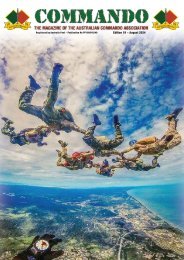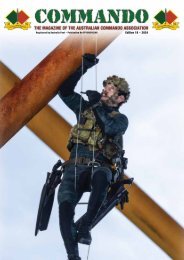Commando News Magazine edition 8 2021
Create successful ePaper yourself
Turn your PDF publications into a flip-book with our unique Google optimized e-Paper software.
The US Marine Raider Stiletto<br />
A replica of the M1918 Mk 1 Trench Knife with brass hilt.<br />
The American made variant used bronze.<br />
U.S. Marine Raider Stiletto. Photo from Wikipedia<br />
Following this the US military decided to design a<br />
more official copy of the Fairbairn-Sykes knife, albeit<br />
with some changes to the design due to financial<br />
concerns. The knife was manufactured by Camillus<br />
Cutlery Co and was in standard delivery decorated on<br />
the blade with the letters "USMC" framed by leaves.<br />
Some 15,000 were manufactured, although only ca<br />
6,000 marines served as Raiders.<br />
However, the changes to this version of the fighting<br />
knife had turned out to be serious flaws. The hilt was a<br />
zinc-aluminum one-piece die-cast directly onto the<br />
tang and with time, the zinc ions leaked out, leaving<br />
the hilt very brittle and weak. Furthermore, for<br />
economical reasons the blade had been made thinner<br />
and as the tempering was also inferior the whole knife<br />
was rather fragile, if still deadly when used correctly. A<br />
retired USMC commented on it in the following words:<br />
It was pointed out that it should never be<br />
thrown, as it was designed as a hand-held weapon<br />
to be used only in combat. It was also pointed out<br />
that it was brittle and would break even if just<br />
dropped, particularly the point.<br />
— M.G. Oscar F. Peatross, USMC retired<br />
Consequently, non-commando troops commonly<br />
found it lacking for fighting and their need for every<br />
day utility use wasn't nearly satisfied, with it's inherent<br />
weakness and completely round grip. They would<br />
much rather have a more versatile tool that would not<br />
just let them fight, but also let them hammer, pry open<br />
boxes and tins & cans, cut wire, split wood etc.<br />
Consequently, for some troops, the stiletto was thus for<br />
a brief period replaced by short machetes or even<br />
personal hunting knives, commonly of Bowie-like<br />
designs like the Randall Model 1 and the Marble's Ideal<br />
hunting knife, where the latter likely served as<br />
inspiration for what was to come.<br />
Support for the knife was mixed but the expensive<br />
bronze knuckle hilt limited the gripping options and<br />
the somewhat weak blade had a tendency to break<br />
when prying things. As such it was not a success and in<br />
1943 it was replaced by the M3 Fighting Knife. Some<br />
troops however, initially received the Raider Stiletto<br />
described above.<br />
US Army M3 Fighting Knife with M8 scabbard. Private<br />
collection displayed at warrelics.eu<br />
The M3 Fighting Knife in in turn would be highly<br />
influential on military knives around the world and<br />
served as the role model for many, many military knives<br />
which more or less copied the design.<br />
The USMC Mark 2 Combat Knife<br />
As a result of the issues with the Raider Stilettos and<br />
the Mark 1 Trench Knives, the USMC issued a speci fica -<br />
tion for a request for a modern and more versatile<br />
fighting knife, sent to several military knife & tool<br />
suppliers in 1942. The starting point was to be the US<br />
Navy Mark 1 Utility knife and the Marble Ideal. Basic<br />
requirements included e.g. good strength and<br />
durability, reasonable cost and low enough weight for<br />
The Mark 1 Trench Knife & Mark 3 Fighting Knife<br />
Still in WWII the old WWI Mark 1 Trench Knife<br />
(M1918) was reissued by the Army as a large stock<br />
remained from WWI. Most of these were issued to<br />
Army Rangers and Airborne troops, but some were<br />
reissued to Marines, in particular Raiders.<br />
Blueprint showing the blade and full hidden stick tang<br />
construction. The blueprint shows a bigger clip point than the<br />
Camillus depicted below, with the beveling extending all the<br />
way over the fuller.<br />
COMMANDO ~ The <strong>Magazine</strong> of the Australian <strong>Commando</strong> Association ~ Edition 8 I <strong>2021</strong> 45
















